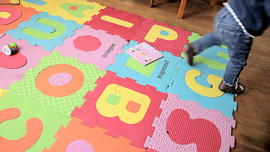5 ways to make reading fun for your child

The more children enjoy reading, the more they'll read. We've got 5 tips to help foster your child’s love of reading.
1. Keep reading experiences active and engaging
Keep in mind that just reading more is not enough. Research has shown that the type of reading matters. The more engaging and active the reading experience, the more it benefits the child. Try this:
- Make story books come to life by giving characters different voices and adding drama to the narration. This helps children realize that beneath the surface of the text, there is a great story filled with imagination.
- Help your child interact with the reading material. Ask questions (What do you think the king will do next? Which planet is closest to the sun?). Think aloud (I wonder why the baby bunny felt afraid? That starfish reminds me of the one we saw on our trip to the beach.).
- Encourage your child to interrupt you if there is an unfamiliar word. Have your child demonstrate their understanding of the text by pointing to illustrations (Can you point to the bear that looks tired? Where is the bird’s nest?).
2. Build on your child’s passions, questions and preferences
Studies show that when children are excited about a topic, they will keep reading. Even the most active children can get lost in a book—or a website, or an adventure-packed comic book that matches their passions and preferences. Children’s librarians and bookstore owners are precious allies, but there are online resources as well, including the Children’s Choice Booklists published each year by the International Reading Association.
3. Make reading a social experience
Research suggests that children who choose to read for fun see themselves as part of a community with other readers—discussing what they’re reading, making recommendations, even debating the value of an author’s intended message. This can start with a chat over something you’ve read aloud with your child (older children benefit from read aloud experiences just as much as the younger ones). And if other readers are not at home, you can seek out book clubs in local libraries or book stores, or encourage your child to connect less formally with friends or cousins after school or via email.
4. Teach your child the “Five-Finger Test”
The "Five-Finger Test" helps children find books at the right level. Studies show that children are more motivated to read when they feel successful and can approach books with confidence. If your child is choosing books that are too difficult, encourage them to do the following: Read one page of the book. If there are more than five unknown words, choose a different book.
5. Be a reading role model
As children observe their parents reading books, emails, magazines and webpages, they are developing their first understandings of how reading-related activities can provide entertainment and fun, help people communicate and connect, and teach us something new.












